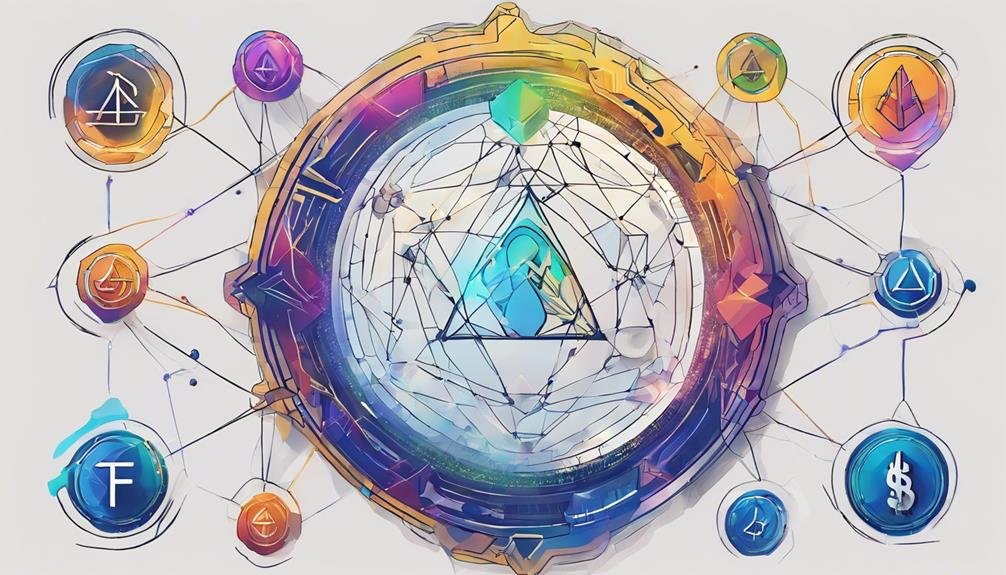Security is crucial in digital currency anchors. Cryptographic techniques like public-key cryptography and ECC safeguard transactions. Decentralized networks reduce cyber attack risks with consensus mechanisms and blockchain tech. Proof-of-stake enhances network security and is eco-friendly. Cryptocurrency Security Standards establish best practices. Risk assessments and encryption guarantee transaction integrity. Strong password policies and multi-factor authentication bolster account security. These aspects strengthen your assets in the fast-paced digital landscape, safeguarding your investments and transactions.
Table of Contents
Brief Overview of 7 Best Security Features of Stablecoin Technology
- Public-key cryptography ensures transaction protection.
- Decentralization reduces cyber attack vulnerability.
- Proof-of-Stake enhances network security.
- Compliance with CCSS strengthens digital asset security.
- Multi-factor authentication safeguards account access.
Advanced Cryptographic Techniques
When exploring the realm of digital currency security, advanced cryptographic techniques such as Elliptic Curve Cryptography (ECC) are vital for protecting transactions. ECC is a type of public-key cryptography that secures the transfer of digital assets by establishing a secure communication channel between parties involved in a transaction. This cryptographic method is highly effective and widely adopted in the crypto world due to its robust security features.
Zero-knowledge proofs (ZKPs) are another essential element in digital currency security. ZKPs allow one party, the prover, to demonstrate to another party, the verifier, that they know a specific piece of information without disclosing the actual information itself. This adds a layer of privacy and confidentiality to transactions, ensuring that sensitive data remains secure.
Homomorphic encryption is a groundbreaking technique that enables computations to be carried out on encrypted data without decrypting it first. This method ensures that sensitive information in digital currency transactions remains confidential while allowing necessary calculations to occur securely.
Multi-signature schemes further boost security by requiring multiple private keys to authorize transactions. This means that more than one party needs to sign off on a transaction, reducing the risk of unauthorized or fraudulent activity within digital currency systems.
Decentralized Networks

Decentralized networks are not just a feature but a necessity in digital currency security. By distributing control across multiple nodes, these networks significantly reduce vulnerability to cyber-attacks and manipulation. Consensus mechanisms play a crucial role in guaranteeing the integrity and security of transactions, fostering trust and resilience in the system.
Network Security Measures
Implementing robust network security measures in decentralized networks is essential for ensuring the integrity and safety of digital currency transactions. Decentralized networks powered by Blockchain technology distribute transaction data across multiple nodes to enhance security. Security features such as cryptographic algorithms and peer verification play a vital role in safeguarding transactions and preventing unauthorized access.
Consensus mechanisms like proof-of-work or proof-of-stake further enhance network security by validating transactions and maintaining the integrity of the blockchain. By avoiding single points of failure, decentralized systems reduce the risk of cyber attacks, providing a more secure environment for digital currency transactions than traditional central bank systems. Nodes within these networks validate and record transactions, contributing to the overall security and transparency of the digital currency ecosystem.
Trustless Transactions
Trustless transactions in decentralized networks are not just a trend but a game-changer. They enhance security and reduce counterparty risks, eliminating the need for intermediaries. Decentralized networks rely on consensus mechanisms such as proof-of-work or proof-of-stake to validate transactions, ensuring transparency and integrity. Essential contracts are not just a concept; they are the key to these networks, enabling automated, self-executing agreements without third-party oversight enhancing security and efficiency.
Using cryptographic principles, decentralized networks secure transactions, safeguard user data, and prevent unauthorized access. Trustless transactions in decentralized networks are not just a feature but a shift towards a more secure, transparent, and efficient financial ecosystem, offering safe and accessible payment solutions to underserved populations.
Immutable Ledger Technology
Utilizing immutable ledger technology in decentralized networks establishes a foundation for secure and transparent record-keeping. In systems like blockchain, once data is recorded, it becomes unalterable, guaranteeing data integrity. By spreading data across multiple nodes, decentralized networks eliminate a single point of failure, enhancing security. Transactions within these networks are transparent and secure, thanks to cryptographic protocols that validate and secure data.
The decentralized nature of blockchain reduces the risk of unauthorized access, providing a level of trust in digital currency transactions. This technology guarantees the immutability of records and enhances transparency, making it a reliable and secure way to conduct transactions in the digital world.
Proof-of-Stake Consensus Methods

Proof-of-Stake (PoS) consensus methods select validators based on their cryptocurrency holdings to create new blocks in digital currencies. Here’s why PoS is vital for enhancing security and decentralization:
- Decentralization: PoS promotes decentralization by enabling anyone with the required cryptocurrency holdings to participate in block validation, fostering a more inclusive network where power isn’t concentrated in the hands of a few.
- Security: Validators in PoS systems are incentivized to act honestly to safeguard the network. Their staked coins act as collateral, deterring malicious behavior and enhancing the overall security of the blockchain.
- 51% Attack Mitigation: PoS reduces the risk of a 51% attack, a significant threat in blockchain networks. By requiring a large amount of cryptocurrency to control the majority of the network, PoS makes it economically unfeasible for bad actors to attempt such an attack.
- Environmental Sustainability: Unlike Proof-of-Work (PoW) systems, PoS doesn’t rely on energy-intensive mining, making it more environmentally friendly and sustainable in the long run.
Cryptocurrency Security Standards (CCSS)

Cryptocurrency Security Standards (CCSS) are not just guidelines, but the backbone of security within the digital currency domain. By outlining ten key points, CCSS provides a thorough framework for enhancing security in cryptocurrency transactions. Understanding the significance of CCSS, complying with its requirements, and implementing best practices are not just suggestions, but paramount to safeguarding digital assets effectively. Compliance with CCSS is not just a choice, but a responsibility that you hold to protect your investments and transactions.
CCSS Importance Explained
Cryptocurrency Security Standards (CCSS) are essential in safeguarding digital currency platforms by enhancing security practices within the cryptocurrency industry. Understanding the importance of CCSS can help you navigate the system more securely. Here are four key reasons why CCSS is critical:
- Mitigating Security Risks: Following CCSS guidelines can better protect your digital assets from potential threats.
- Standardizing Security Practices: CCSS guarantees that best practices are uniformly implemented across cryptocurrency exchanges.
- Key/Seed Generation: CCSS emphasizes the critical steps of key/seed generation, enhancing the security of wallet creation.
- Managing Security in Central Bank Digital Currency: As central bank digital currencies become more prevalent, adherence to CCSS becomes increasingly essential in securing these new systems.
Compliance Requirements Overview
To guarantee strong security practices in the cryptocurrency industry, grasping the Compliance Requirements Overview of Cryptocurrency Security Standards (CCSS) is essential. CCSS specifies key points to standardize security measures, emphasizing necessary steps like key/seed generation and wallet creation. Adhering to CCSS helps confirm platform security and protects against common security threats.
Encryption is highlighted as a critical aspect of robust security measures, alongside solid passwords and multi-factor authentication. By following these guidelines, platforms can enhance their cryptocurrency security and better safeguard user assets. Understanding the compliance requirements outlined in CCSS is fundamental for any digital currency platform looking to establish a secure wallet creation and transactions environment.
Implementation Best Practices
How can you implement the principles of Cryptocurrency Security Standards (CCSS) to enhance platform security and protect user assets? Here are some critical steps to follow:
- Conduct a thorough risk assessment to identify potential vulnerabilities and develop mitigation strategies.
- Safeguard private keys by encrypting and storing them securely to prevent unauthorized access.
- Enforce strong password policies to ensure access to critical systems is restricted and secure.
- Utilize multi-factor authentication to add an extra layer of security and prevent unauthorized access to accounts or sensitive information.
Risk Assessments and Encryption

When evaluating risks in digital currency anchors, encryption emerges as an essential component for ensuring the security and integrity of transactions. Risk assessments are critical in identifying vulnerabilities and potential threats to CBDC systems. Implementing robust encryption techniques is crucial to secure transactions, protect sensitive data, and prevent unauthorized access. By deploying robust encryption protocols, the confidentiality and integrity of digital currency anchor systems can be maintained effectively.
Continuous monitoring and updating of encryption methods are necessary to avoid evolving cyber threats that could compromise the security of CBDC transactions. Encryption technology safeguards transactions and plays a significant role in building trust and confidence among users. Therefore, integrating advanced encryption measures is fundamental in mitigating risks and enhancing the overall security posture of digital currency anchors.
Strong Password Policies

A key measure when securing digital currency anchors involves adopting robust password policies to fortify account protection and deter unauthorized access. To guarantee security, consider the following tips for implementing strong password policies:
- Password Length Requirements: Set minimum password length to create more robust and secure passwords.
- Password Complexity: A combination of uppercase letters, lowercase letters, numbers, and special characters is required to enhance password strength.
- Avoid Password Reuse: Discourage using the same password across multiple platforms to prevent security breaches that could compromise digital currency holdings.
- Regular Updates: Encourage users to periodically change their passwords to reduce the risk of unauthorized access and enhance overall security.
Multi-Factor Authentication

To enhance the security of digital currency anchors, implementing multi-factor authentication is an essential step in safeguarding accounts and assets against unauthorized access. Multi-factor authentication (MFA) goes beyond traditional password protection by requiring users to provide additional verification methods, such as security tokens or one-time codes. By incorporating multiple factors for authentication, MFA dramatically reduces the risk of unauthorized access to digital currency wallets and exchanges. This extra layer of security makes it much harder for attackers to compromise accounts, mitigating the potential for fraud and unauthorized transactions.
Utilizing MFA is a recommended best practice to fortify the security of digital currency assets and accounts against cyber threats. It is a deterrent to malicious actors seeking unauthorized entry into sensitive financial systems. By adopting MFA, users can better protect their digital currency holdings and ensure a higher level of security when conducting transactions in the digital domain.
Frequently Asked Questions
How Is Digital Currency Secure?
Digital currency is secure due to encryption techniques, blockchain technology, private keys, multi-factor authentication, and secure wallets. Your transactions are protected from tampering and fraud, ensuring the safety and integrity of your digital assets.
What Are the Security Concerns of CBDC?
Worried about CBDC security? Guarantee encryption protocols safeguard transactions, addressing privacy concerns. Defend against cyber attacks, uphold regulatory compliance, and implement fraud prevention measures. Trust in the system relies on robust security.
What Are Two Features That Help Make Cryptocurrency Secure?
To enhance security, cryptocurrencies utilize private keys for encryption. Blockchain technology and decentralization guarantee secure transactions. Secure wallets with hardware security, trustless transactions, and consensus algorithms contribute to digital currencies’ overall security.
Which Is the Most Secure Cryptocurrency?
When deciding on the most secure cryptocurrency, consider factors like Bitcoin’s network strength and Ethereum’s smart contracts. Each has its strengths, so explore and choose wisely based on your specific needs.
Conclusion
To sum up, digital currency anchors offer a range of security features, such as advanced cryptographic techniques, decentralized networks, and proof-of-stake consensus methods. Users can protect their assets from potential threats by following cryptocurrency security standards, conducting risk assessments, and implementing strong password policies and multi-factor authentication. With these security measures, digital currency anchors provide a secure and reliable platform for conducting transactions and storing assets online.




